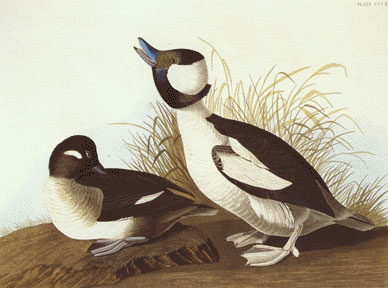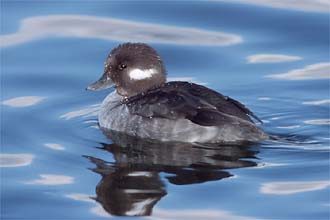| My Bird Buddies
I live on Honeymoon Lake which is a small man made lake.

There used to be a small stream but it was dammed to make a lake for the developers to sell lots on. It's named Honeymoon Lake because it happens to be next to Honeymoon Bay. The story is that Honeymoon Bay used to be called Dogfish Bay. (Dogfish are a small shark prevalent in Puget Sound. Also known as the mud shark that Frank Zappa make famous.) I guess the developers thought that renaming it Honeymoon Lake might make it a little easier to sell lots.
But, like baseball fields, if you build it they will come. There are a variety of birds that live around the lake. Katie asked what kind they were and I said I didn't know birds beyond ducks and seagulls. I actually do know a few more than that, but not much. She thought I should get a bird book. Well, I already have a bird book so, this morning, I started identifying them.

Bufflehead (Bucephala albeola)
These little ducks are wintering over on Honeymoon Lake. We also have the more common mallard, but more about them another time. Bufflehead. What a great name. The picture is by John James Audubon. The following description is also Audubon's.
There are no portions of the Union on the waters of which this beautiful miniature of the Golden-eye Duck is not to be found, either during the autumnal months or in winter; and, therefore, to point out any particular district as more or less favoured by its transient visits would be useless. The miller's dam is ornamented by its presence; the secluded creeks of the Middle States are equally favoured by it as the stagnant bayous and lakes of Lower Louisiana; in the Carolinas and on the Ohio, it is not less frequent; it being known in these different districts by the names of Spirit Duck, Butter-box, Marrionette, Dipper, and Die-dipper. It generally returns from the far north, where it is said to breed, about the beginning of September, and many reach the neighbourhood of New Orleans by the middle of October, at which period I have also observed them in the Floridas. Their departure from these different portions of our country varies from the beginning of March to the end of May. On the 11th of that month in 1833, I shot some of them near Eastport in Maine. None of them have, I believe, been found breeding within the limits of the Union. During the period of their movements towards the north, I found them exceedingly abundant on the waters of the Bay of Fundy, the males in flocks, and in full dress, preceding the females about a fortnight, as is the case with many other birds.
[read more]
There were three females and one male out on the lake this noon. The females were hanging out on my side of the lake while the male was on the other side. They swim lower in the water that the mallards. They are underwater swimmers. They dive under the water and are gone. They will pop up 30 feet away from where they dove in.
Here are more links to this little duck with the funny name.
Bufflehead Duck (Bucephala albeola)
Bufflehead
BUFFLEHEAD
Waterfowl Identification in the Central Flyway

|

